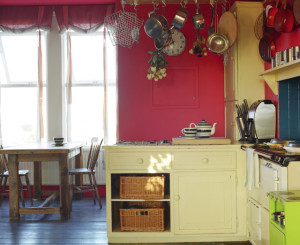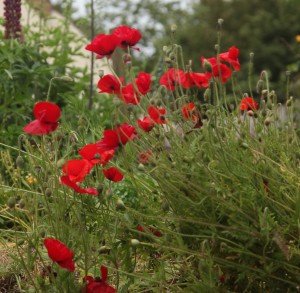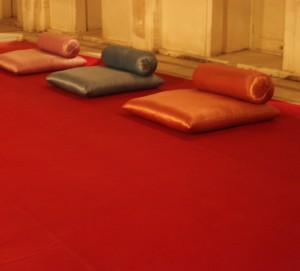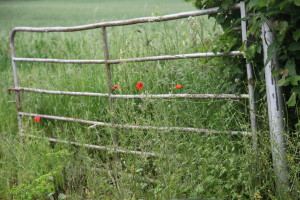Rolled blinds are soft and often without formal rollers or rods to take them up and down. They are often rolled by hand, the roll held in place by cords or ties – a system which works fully only when one can reach the whole blind. Otherwise the bottom section only is rolled up and down. This works when the blind remains mostly lowered for some reason. Perhaps to direct the light low into the room or to cover something ugly outside at the top of the window; just the bottom part rolled up. For small windows a rudimentary cord and pulley system can be used quite effectively. The cords run from rollers at the top down the front of the blind and up the back, as the cords are pulled the cords pull the blinds fabric up into a roll or soft pleats. The cords remain showing at the front of the blind.
These were made in two linens with silk ties for some elegance. Designed to stay down for most of the time, rolled simply at the hem. Their function is to filter strong light from bright open skies and to suffuse the kitchen with colour. They can be rolled fully up with careful pulling, and if they get stuck, by hopping up onto a chair or a stool.
FROM THE BLOG :
This is a small example, but in the here the walls, the linen blind and the silk sash tie are all tones of a very similar colour – the silk tie is also shot with gold, so a warmth and reflective quality has also been brought in. The wooden table, the floorboards, and now the bread are also welcoming and warm in their golden-ness. So with the blue chairs we essentially have full a colour spectrum – red/ yellow / blue, well balanced in tone and depth. And not only that, but the reds and yellows pick up the terracottas in the roofscapes beyond and the blue picks up the sky. So the colours work within and without and from one space to another.
I guess the question we’re most frequently asked ( not so much by clients as by their friends and visitors ) is how we put colours together – how we make the choices and where we find the materials, but mostly what people really want to know is something on the lines of ‘how do we know it’s going to work ?’ It’s so easy isn’t it, to see something someone else has done – a photo in a magazine or an advert, or a friends home – to fall in love with an idea and to copy it. Except it isn’t – it’s so very much harder than it looks, as anyone who has ever gone into the shop knowing exactly what they wanted and come out confused, with nothing, can attest. It is of course, much harder to work for yourself than for someone else – the thought processes which remain clear and focussed for a client can turn to mush, or at least go fuzzy, when it comes close to home. Even the great David Hicks confessed to this at a lecture I was at – even if nowhere else – so do take heart !
It is about keeping clear head, but it’s also about confidence and taking a sure path. Not being afraid of a strong colour – if that’s what you want, but then making sure it’s well balanced. The colour wheel shows us the pigments: nature, with all it’s nuance and shading and toning and change of temperature and sound, shows us how. Take a flower and look at it closely – see how many tones of colour there really are in a ‘solid’ petal. Look at the centre, the stem the leaves – it’s complex. Then look at where it grows, and what with, and you’ll realise just how much we are actually taking in when we look but how little we really see. So that when we come to interpret ‘the look ‘ we are inclined to make our judgements and choices too narrow – to mirror the picture we think we’ve seen, rather than the comprehensive reality.
And the texture and sense of it matters – here the example is the field poppy, which is a fighter, but fragile and almost waif – like when compared to the more solid hybrids that we grow in the garden. So we need to consider as well, how we can capture and convey not just the colour, but something of the fragility (or conversely the solidity) of the inspiration we’ve chosen. Fabrics – the weave and textures – help hugely. The better quality the colouring and the more natural the dyes, the higher the chances are that a textile will contain something of the complexity of the natural world. So it’s worth looking to find the best.
It’s by looking at colours as we see them in our everyday lives and thinking about what they are surrounded by that will help us to create harmonious interiors with depth and nuance. None of the images below actually provided the inspiration for this work, but several of them might have done. This room was completed long before these photos were taken, but look at the picture of the room, then the others en masse and see how close they are.







